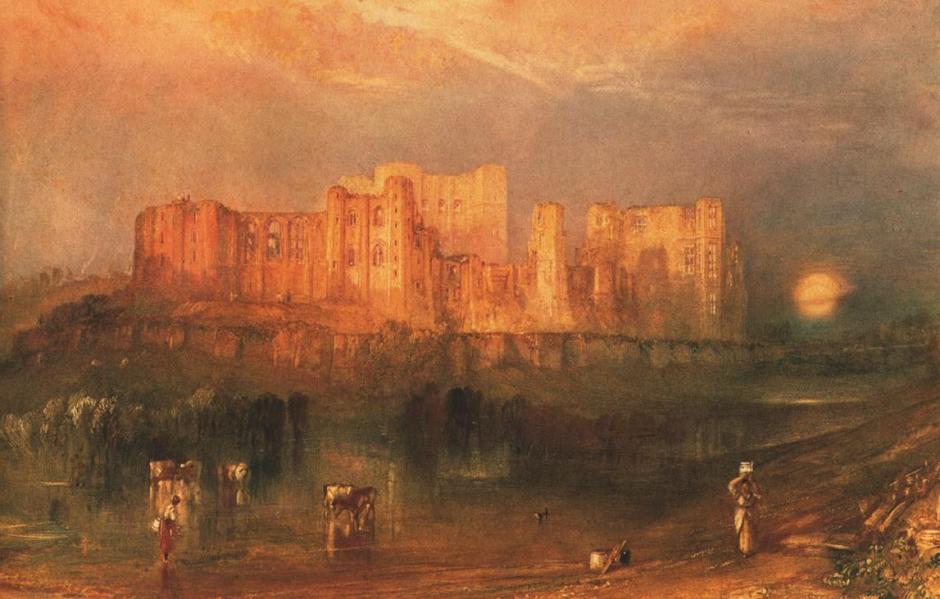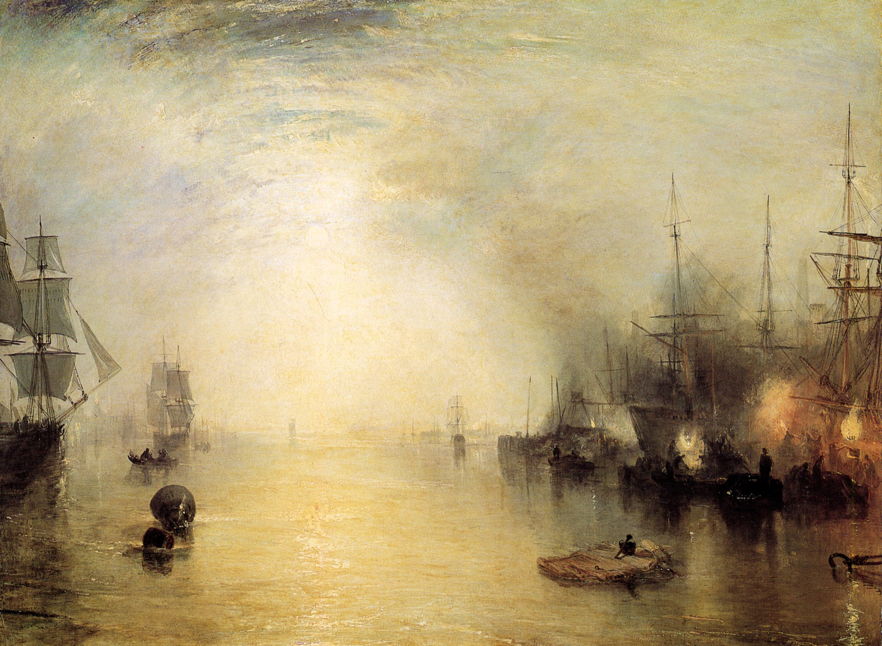This evocatively shot period biopic of the latter part of JMW Turner’s life offers deeper glimpses into his painting.

“Mr. Turner”
written and directed by Mike Leigh
starring Timothy Spall, Dorothy Atkinson, and others
music by Gary Yershon
cinematography by Dick Pope
edited by Jon Gregory
Film4 et al.; Entertainment One; Sony Pictures Classics (US distribution).
Running time 144 min.
Theatre release October 2014
iTunes Feb 2015; DVD, Bluray Mar 2015.
IMDb
Wikipedia
Good movies about artists are uncommon, and great ones are as rare as hen’s teeth. Having watched Mike Leigh’s chronicle of the last 25 years or so of JMW Turner’s life, in a theatre last November and at last on iTunes (HD, on a 27 inch display), I am inclined to classify it as great, and to want to watch it at least a third time.
Leigh wastes no time in introducing us to both his character and Dick Pope’s stunning cinematography, showing Turner sketching feverishly amid the windmills painted by a Dutch dawn. At first, on Turner’s return to the period early nineteenth century London, you might think that his guttural grunts and ornate language seem a bit ham, but you soon settle down to the brusque matter-of-fact manner of both the painter and his father, working as studio assistant and factotum.
Turner’s character is developed steadily as he travels to Petworth House and sketches among the nobility and gorgeous interiors there. Although not an overt attempt to break into his mind and artistic intent, Leigh gives us valuable and I think very accurate glimpses into Turner’s inner, sensitive intellect. These contradictions between his bluff exterior and inner feeling reach a climax in Turner’s anguish by his father’s deathbed.
There are also many subtle references to Turner’s work and its influences. Mrs Booth’s husband, a skipper of slaving ships, puts Turner into a pensive gaze with his artist’s eye, for the painting of his moving essay on the immorality and inhumanity of the slave trade. A boat outing with fellow artists comes across the Fighting Temeraire being towed for scrap, so the painting of that poignant view. Pope’s shots of the latter scene do justice to Turner’s painting.
As Turner travels to the South Coast and develops his relationship with Mrs Booth, there are stunningly lit views of the chalk cliffs, and later of a mountain lake (I think Cader Idris, but could be mistaken). The bickering and competition between top-hatted painters at the Royal Academy on ‘varnishing day’, when Turner was known to completely repaint some of his works, is wonderfully recreated, and the knowledgeable viewer will spot John Constable in decline, and several lesser painters and paintings of the period.
There are a couple of less comfortable moments with Hannah Darby, his housekeeper, when he first gropes her roughly, and their later peremptory screws her pressed up against a bookcase. Those jarred, and contrasted with Leigh’s more subtle approach to Turner’s relationship with the twice-widowed Mrs Booth.
I am also a little puzzled that Leigh showed Turner lashed to the mast of a ship during a severe blizzard: I had always assumed that to be one of the more legendary episodes in his life, embellished to give credence to his near-impressionist paintings. I also cannot see how necessary it was in the creation of the work, particularly as there were only the ship’s weak oil lamps which could have lit the scene before him. However Leigh accepts the story, and quietly elides over Turner’s well-known addiction to snuff.
The movie culminates in a gloriously moving recreation of Turner’s deathbed, another brilliantly shot scene, which left no dry eye in the theatre, everyone filled with bittersweet pleasure in Turner’s life and works, and sadness at his end.
Although Mike Leigh is no stranger to movies, it is a long time since we last saw him on this sort of form, with his moving study of backstreet abortion in Vera Drake (2004, also shot by Pope). His script, and Pope’s shots, are beautifully complemented by Gary Yershon’s music, which never intrudes but only augments.
There is something strange, though, about the women in this movie: all the more prominent seem fatally weak, flawed, or both. Hannah Danby, Turner’s psoriatic housekeeper, is portrayed as the object of his sexual relief and too feebleminded to change the water in the studio. Sophia Booth, the landlady with whom he set up house in Chelsea, is an amiable airhead. Mary Somerville is a pseudo-scientific fraudster trying to magnetise a needle using violet light, rather than a polymath. Sarah Danby, Turner’s first common-law wife and mother of his two daughters, is shunned as exploiting Turner’s success. Turner’s mother, of course, was overwhelmed with psychosis and committed to an asylum long before the events shown in this movie. Even Eliza, the young prostitute, is disinterested and weary, and the young Queen Victoria is shown as unappreciative.
I am not sure whether Turner really did live in such a thoroughly misogynistic world, or whether Mike Leigh intended it to be so. However it does not detract from the best artistic biopic I have seen for years, and the most insightful tribute to Turner’s huge achievements. If you can, watch it in a theatre – it is well worth the effort.

